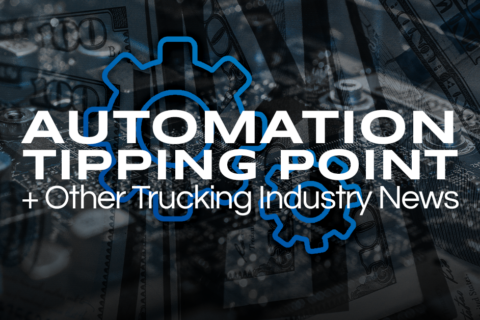Major Automakers are Bringing EV Production to the U.S. + Other Trucking Topics
Welcome to Optimum Logistic’s weekly news recap! This week we are discussing the push behind electric vehicle production, the opportunity to rise up the occupational ladder with Trucker Tennessee, and how Stack AV’s autonomous trucking business seeks to revolutionize the trucking and freight industry. Through partnerships and government incentives, EV focus is gaining ground, exposing individuals to the potential for career growth, and ensuring goods can be transported safely and efficiently worldwide. If you’re an industrial or logistics professional interested in staying abreast of transport trends, this post is for you! Read on for a taste of the latest in the world of trucking, EVs, and more. Joint Venture Formed to Promote Electric Vehicle Production Three major automakers have formed a joint venture to produce electric vehicle batteries in the U.S. Daimler Truck, Paccar Inc. and Cummins Inc. each have a 30% stake in the venture, with EVE Energy, a Chinese battery manufacturer, making up the remaining 10%. Overwhelming Investment The total estimated investment in the joint venture is between $2-3 billion, making it one of the largest investments related to electric vehicles (EVs) to date. Several other automakers, including General Motors Corporation, Ford, and Stellantis are investing heavily in similar ventures. Ford, for example, has already announced an $890 million investment in battery production partners SK On and EcoProBM this past August. Growing Incentives Government incentives such as the Inflation Reduction Act and CHIPS and Science Act are designed to promote zero-emission EVs and boost production of related technologies in the U.S. As a result of these incentives, more than $150 billion in EV-related manufacturing plant projects have already been proposed across 16 U.S. states. The stakes are particularly high in California, which is banning new internal combustion-powered trucks from its roads by 2035. Government Approval The newly formed venture has been subject to review by the Committee on Foreign Investment in the U.S. (CFIUS), a government body responsible for protecting the country’s best interests in the face of major foreign investment and merger activities. Whether you are a trucking company provisioning for future requirements, or a logistics and industrial staffing company looking to prepare your workforce for the energy transition in trucking and EV production, this joint venture is a monumental step in the right direction concerning EV production. 🔗 Learn more about U.S. EV production leaps. Time to Climb the Occupational Ladder? The Tennessee Board of Regents (TBR) recently began a new initiative called Trucking Tennessee to increase awareness of the 70,000 truck driver jobs available across the country and address the shortage of drivers in Tennessee. Jason York from Frontier Transportation in Knoxville acknowledges the challenge of convincing people to look into these jobs, requiring long hours away from home. But, the need for driver hiring will continue to grow proportionately to the country’s population over the next decade. In East Tennessee, Tennessee Truck Driving School is the place to learn the necessary skills and have an opportunity to break into the trucking industry with job placements. What the Road Ahead May Look Like Although the job may be difficult to navigate, it leads to potential personal growth and mobility in the trucking industry. It’s estimated that by 2030, the truck driving industry will have seen a 20 percent jump in available positions. Companies such as Frontier Transportation are on board with the TBR’s initiative to bridge the gap in available drivers. Trucker Tennessee is the perfect place for people to learn more about this career and take their first steps into the field. 🔗 Explore TBR’s Tennessee Trucking Transformation here. Redefining the Way Goods are Transported Stack AV has launched its autonomous trucking business with the mission to revolutionize the trucking and freight industries! Leveraging its self-driving technology, Stack AV designs solutions to alleviate shortages, enhance safety and efficiency, and reduce operating costs and emission levels. Backed by SoftBank Group Corp., Stack AV is led by experienced leaders in the development of autonomy-enabled systems to optimize and improve the current supply chain. Ethics, Efficacy, and Automation Led by Chief Executive Officer Bryan Salesky, President Peter Rander, and Chief Technology Officer Brett Browning, Stack AV is headquartered in Pittsburgh, Pennsylvania with over 150 employees across the country. Stack AV’s advanced AI-powered autonomous driving system can change the transportation of goods and supply chains for its partners, allowing them to deliver goods to their consumers faster and more safely. Weakened by driver shortages, long-term safety concerns, and high operating costs, the trucking industry needs an upgrade to become more efficient and reliable. Stack AV is the answer and is ready to take trucking and freight into a new era with its self-driving technology and AI-driven solutions. 🔗 Discover how Stack AV is revolutionizing the trucking industry here. Before You Hit The Road… That about ties up another exciting week in the world of trucking and EV production. From joint ventures looking to increase EV accessibility, the need for new drivers across the nation, to Stack AV’s autonomous trucking business, there is a great deal of potential for success in the industry. As a trucker, logistics professional, or even just an individual interested in the EV industry, these stories are worth taking note of. That being said, we’d love to hear from you! Which story do you find the most intriguing? How will it affect the industry? Share your opinions in the comments section below and don’t forget to check back next week for another edition of Optimum Logistic’s weekly news recap! If you made it to this part of the article, we’d just like to take a moment to thank you for taking the time to read this weekly recap. Be safe out there and as always, If you’re in search of CDL A, B, or warehouse positions, check out our open positions. And if you need staffing solutions for commercial driving or industrial positions, be sure to explore our offerings.











Recent Comments